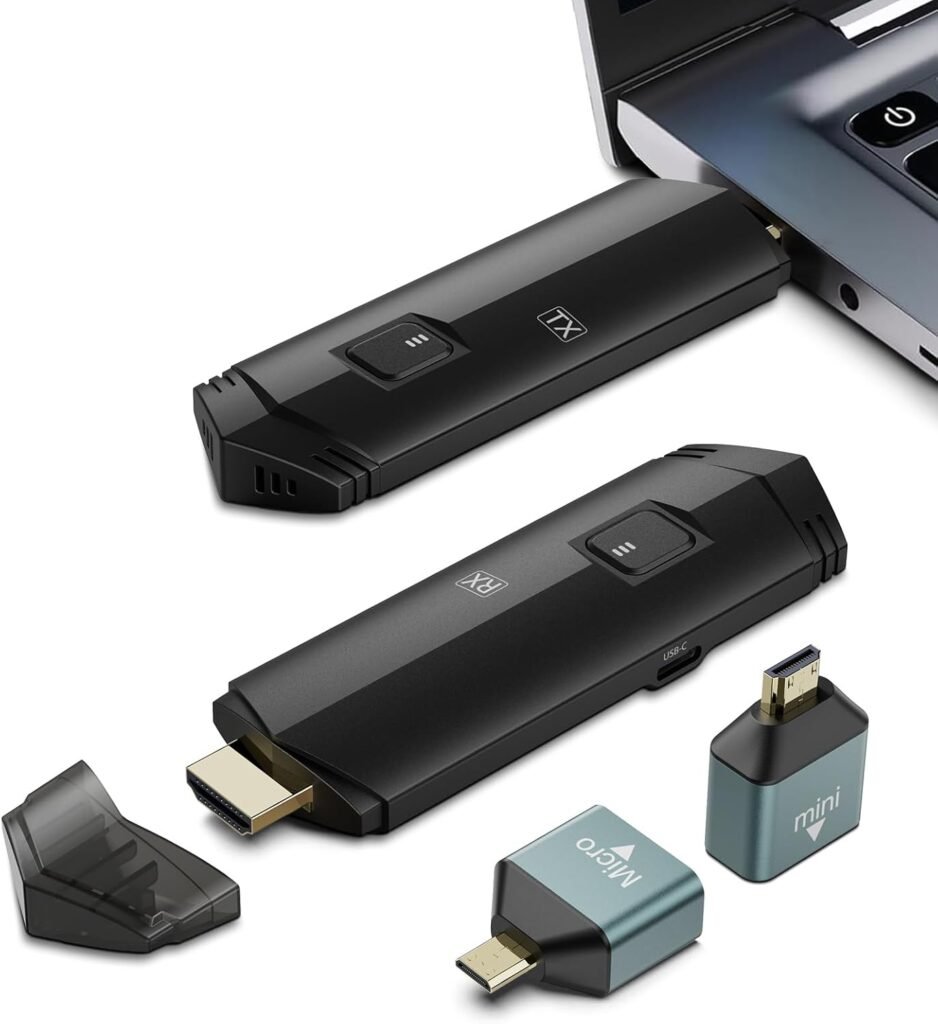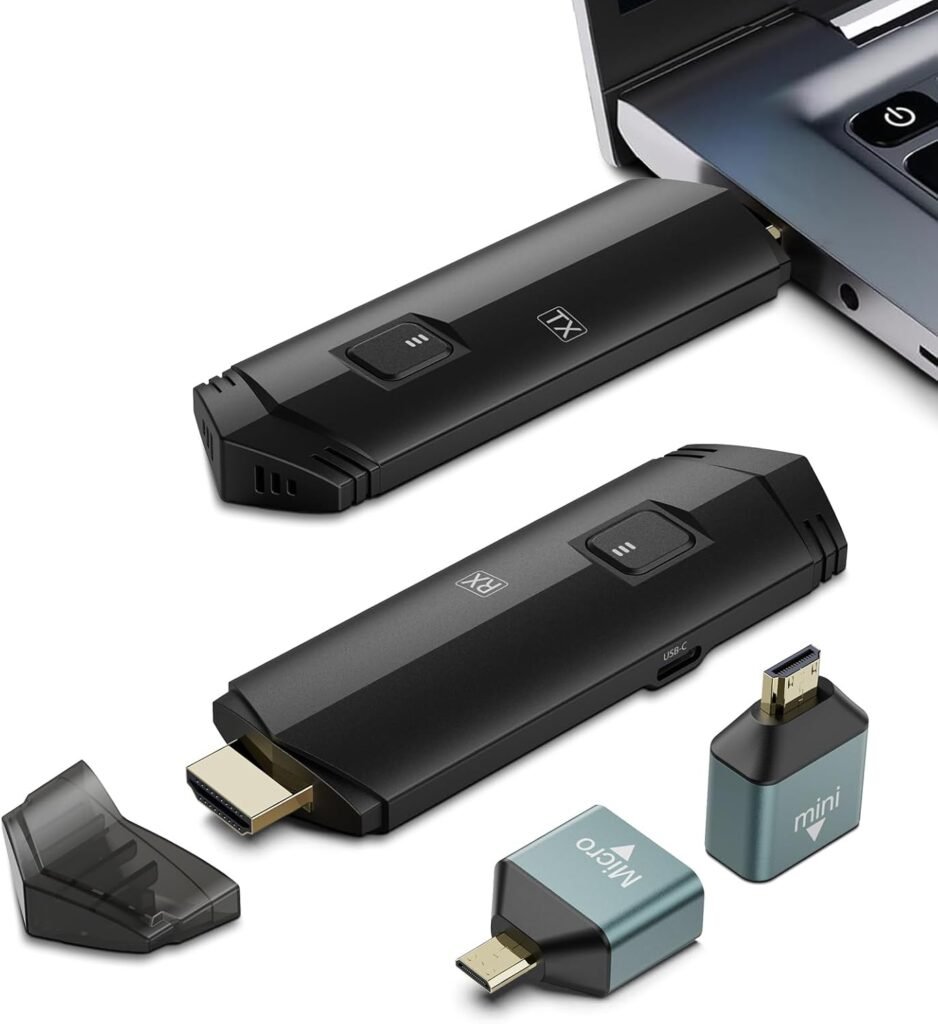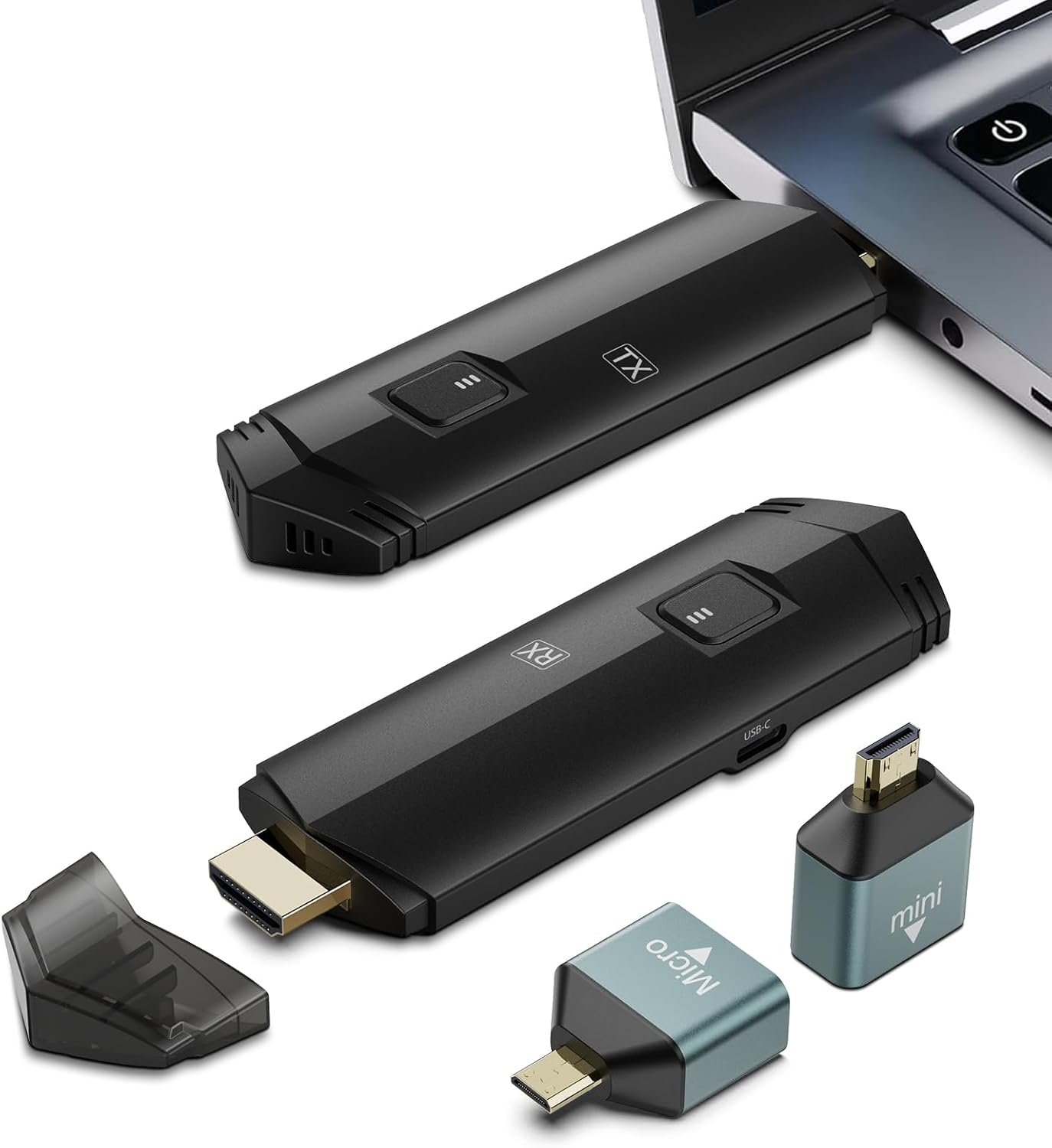Wireless HDMI Transmitter and Receiver 4K, Portable Wireless HDMI Extender 100FT Range, 2.4G/5G Plug & Play, Streaming from Laptop/PC/TV Box/Camera to Monitor/Projector/HDTV (Black)
Table of Contents
AI-generated image

Use this image as:Set featured Image as thumbnailInsert this image inside content
Exploring the Benefits of Wireless HDMI Transmitters and Receivers: A Comprehensive Guide to 4K Connectivity
Introduction to Wireless HDMI Technology

Wireless HDMI technology represents a significant advancement in video and audio transmission, distinguishing itself from traditional HDMI connections by eliminating the need for physical cables. This innovative technology uses radio frequency or wireless signals to transmit high-definition video and audio signals from a source device, such as a Blu-ray player or gaming console, to a display device like a television or projector. The transition from wired to wireless transmission has become increasingly important in today’s digital landscape, where convenience and flexibility are paramount.
One of the primary advantages of wireless HDMI transmitters and receivers is their ability to support high-definition (HD) and even 4K resolutions without the hassle and limitations of physical cables. This capabilitynot only enhances the viewing experience by removing cable clutter but also allows users the freedom to position their devices in ways that best suit their environment. Additionally, advancements in wireless technology have significantly improved the range and reliability of these connections, ensuring minimized latency and optimal performance even in larger spaces.
Wireless HDMI technology also addresses several limitations of traditional HDMI setups. For instance, it allows for seamless streaming from multiple devices without the need to switch cables or ports. This flexibility is particularly beneficial in home entertainment systems where users may switch frequently between various inputs. Moreover, capabilities such as 3D video support and multi-channel audio transmission further enhance the user experience, making wireless HDMI a versatile solution for both consumers and professionals.
Overall, wireless HDMI technology has paved the way for more efficient and user-friendly audio-visual systems, while continuously evolving to meet the demands of contemporary streaming and media consumption. Its significance in modern connectivity cannot be understated, making it an essential feature for anyone looking to enhance their audio-visual experience.
Understanding 4K Wireless HDMI Transmitters and Receivers
4K wireless HDMI transmitters and receivers represent a significant advancement in the realm of audio-visual technology. These devices are designed to transmit ultra-high-definition (UHD) video resolutions, which provide users with a cinematic experience by delivering four times the resolution of standard 1080p HD. To fully harness the capabilities of 4K wireless HDMI technology, it is essential to consider the technical specifications that dictate their performance.https://amzn.to/40Tfdrg
One of the primary specifications to examine is bandwidth. In general, a wireless HDMI transmitter must support at least 18 Gbps of bandwidth to effectively transmit 4K video at 60 frames per second (fps) without compromising image quality. This high bandwidth enables rich color depth and a more fluid visual experience, essential for modern content consumption. Additionally, most devices feature support for various color formats, such as HDR (High Dynamic Range), which enriches color accuracy and brightness contrasts, further enhancing the viewing experience.
Another important aspect is the range of transmission. Many 4K wireless HDMI systems can operate effectively over distances reaching up to 100 feet, depending on environmental factors. This flexibility allows for versatile placement of devices and eliminates the hassle of long cables, making setups cleaner and more ergonomic. Furthermore, advancements in wireless technologies such as Wi-Fi Direct and proprietary protocols help minimize latency and freezing, which is particularly beneficial during high-energy viewing experiences like gaming or sports.
Upgrading to a 4K wireless HDMI transmitter and receiver not only elevates the visual quality but also future-proofs one’s setup. As streaming services increasingly offer content in 4K resolution, investing in these devices becomes a prudent choice for those seeking to enhance their audio-visual experiences. Transitioning from lower resolutions to 4K can noticeably improve clarity, detail, and overall picture quality, marking a distinct evolution in home entertainment systems.
The Advantages of Using a Portable Wireless HDMI Extender
RALEED ARTICLES#https://asadmarket.com/wp-admin/post.php?post=298&action=edit#/
In an increasingly digital world, the demand for versatile and efficient connectivity solutions has surged. Portable wireless HDMI extenders serve as a remarkable response to this need, offering a plethora of advantages that cater to both professional and personal environments. One of the primary benefits is the enhanced user flexibility they provide. Unlike traditional wired systems, which often confine users to specific locations, wireless HDMI extenders allow individuals to place their video sources and displays wherever they are most needed. This is particularly advantageous in settings where frequent movement or reconfiguration of equipment is necessary, such as classrooms, conference rooms, or during live events.
Additionally, the ease of setup associated with portable wireless HDMI extenders significantly simplifies the user experience. Typically, users can establish a connection within minutes—eliminating the hassle of dealing with multiple cables and connectors. This straightforward installation process not only reduces setup time but also minimizes the potential for technical complications that often accompany wired setups. Moreover, portable extenders allow users to connect a variety of devices like laptops, gaming consoles, and projectors with minimal effort, making them highly adaptable to varying needs and preferences.
Another compelling aspect of these extenders is their applicability in different scenarios. For instance, in home entertainment, users can seamlessly stream 4K content from their entertainment centers to any room without the restriction imposed by physical connections. In contrast, business environments can leverage portable wireless HDMI extenders for presentations, video conferencing, or digital signage, fostering enhanced communication and collaboration. Overall, the transformative benefits of using portable wireless HDMI extenders present an attractive option that enhances both convenience and efficiency in diverse settings.
Range and Performance: 100ft Coverage Insights
Wireless HDMI transmitters and receivers have gained considerable attention due to their ability to eliminate the limitations presented by traditional HDMI cables. The 100ft range feature in these devices allows for greater flexibility in setting up home theaters or conference rooms. This capability is particularly beneficial when aiming to transmit high-definition video signals over long distances without compromising quality.
When considering distance, it is essential to understand how it can potentially affect video quality. At 100ft, the signal integrity will largely depend on factors such as interference from other wireless devices, the quality of the transmitter and receiver, as well as any physical obstacles in the environment. Thick walls, metal structures, and electronic devices can disrupt the signal transmission, leading to reduced image quality or lag. Users should be aware that to maintain optimal video quality at the upper limits of 100ft, minimizing potential obstructions is crucial.
To further enhance the connection’s performance, users can adopt several strategies. Positioning the transmitter and receiver in a straight line, free from physical barriers, can greatly improve signal strength. Additionally, the use of high-quality wireless HDMI devices specifically designed for long-range connectivity ensures better resilience against signal degradation. If experiencing issues, users should consider relocating devices or adjusting antenna angles to find the most effective setup. In many cases, elevating either the transmitter or receiver may help achieve a clearer line of sight, thereby improving connectivity and performance stability.
Overall, understanding the nuances of range and performance in wireless HDMI technology can aid users in achieving the best possible experience with their audiovisual setup. By recognizing the potential challenges associated with a 100ft range and implementing appropriate solutions, maintaining high-quality 4K video transmission becomes not only achievable but also enjoyable.
Frequency Bands: 2.4GHz and 5GHz Explained
The choice between 2.4GHz and 5GHz frequency bands is pivotal for optimizing wireless HDMI connections. Each frequency band possesses distinctive characteristics that influence performance in various environments. The 2.4GHz band, which is also utilized by many household devices, offers greater range, making it ideal for larger spaces where signals might need to traverse obstacles such as walls. However, this band is more susceptible to interference from other electronics, which may degrade performance, particularly in congested environments.
On the other hand, the 5GHz band provides higher data rates and less interference, as it has a wider range of clear channels. This makes it well-suited for high-definition and 4K video streaming, where bandwidth is critical. The reduced risk of interference enhances the HDMI streaming experience, especially in close-proximity setups. However, the downside is that the 5GHz band has a shorter range compared to 2.4GHz. It is less effective when dealing with physical barriers, which can weaken the signal and lead to connectivity issues in larger setups.
Choosing the appropriate band depends on the specific use case. For instance, if the transmitting and receiving devices are in adjacent rooms or the same space, the 5GHz band would likely deliver superior performance, ensuring a seamless streaming experience. Conversely, if the devices are distant or the space is cluttered, the 2.4GHz band might be the better choice to maintain connectivity. It is essential to evaluate the surrounding environment and the devices’ requirements before settling on a frequency band to enhance the wireless HDMI setup.
Installation and Setup: A Step-by-Step Guide

Wireless HDMI Transmitter and Receiver 4K, Portable Wireless HDMI Extender 100FT Range, 2.4G/5G Plug & Play, Streaming from Laptop/PC/TV Box/Camera to Monitor/Projector/HDTV (Blac
Setting up wireless HDMI transmitters and receivers may seem daunting, but with a systematic approach, the process can be seamless. To begin, it is vital to gather all necessary equipment. This typically includes a wireless HDMI transmitter, a wireless HDMI receiver, power adapters, HDMI cables, and the source device, such as a Blu-ray player or gaming console, along with the display device, such as a television or projector.
Once everything is organized, follow these step-by-step instructions to establish your 4K connectivity:
Step 1: Connect the HDMI Transmitter
Start by connecting the HDMI transmitter to the source device using the provided HDMI cable. Ensure that the connection is secure and check for any visible signs of damage to the cables.
Step 2: Power Up the Devices
Plug the transmitter’s power adapter into a nearby outlet and connect it to the transmitter. Repeat this step for the wireless HDMI receiver, connecting it to the display device via another HDMI cable.
Step 3: Establish Wireless Connection
Once both devices are powered, turn on the source and display devices. On the transmitter, select the appropriate input channel that corresponds to the source device. For the receiver, ensure it is set to receive the signal from the transmitter. This step may require you to access settings menus on both devices for proper configuration.
Step 4: Testing the Connection
After completing the above steps, check the display device to ensure that it is receiving the signal from the source device. You should see the content displayed without significant delay or interference. If issues arise, consult the troubleshooting guide provided by the manufacturer, which may include options like resetting the devices, checking for interferences, or adjusting the placement of the transmitter and receiver.
Following these guidelines will facilitate a successful installation of your wireless HDMI transmitters and receivers, ensuring a smooth setup process for enhanced 4K connectivity.
Choosing the Right Wireless HDMI Solution for Your Needs
When selecting a wireless HDMI transmitter and receiver, several factors must be considered to ensure optimal performance and satisfaction with your purchase. The first aspect to assess is the price point. While affordable options may be enticing, investing in a reliable model from a reputable brand can provide better durability and support for advanced features, which ultimately enhances the viewing experience.
Brand reputation plays a crucial role in the decision-making process. Established manufacturers often offer superior products supported by customer reviews and warranty options. Researching brands known for their performance in wireless technology will help narrow options and facilitate informed choices. Additionally, checking for user feedback and expert reviews online can provide valuable insights into the reliability and satisfaction levels associated with specific models.
Range is another significant consideration. Wireless HDMI transmitters typically operate within defined ranges, and the required distance between the source and the display device should be evaluated. A longer range is essential for larger homes or offices where the devices may be positioned far apart. Ensure that the selected model can efficiently support the necessary distance while maintaining a clear signal.
Resolution support must also align with your current or future viewing needs. Many wireless HDMI systems now support 4K resolution, which allows for high-quality video streaming and gaming experiences. It is advisable to choose a transmitter and receiver that comply with your display device’s capabilities to avoid compatibility issues.
Finally, consider any additional features that may enhance usability. Such elements can include built-in scaling, multiple input options, or support for audio formats. By carefully evaluating these criteria, consumers can choose the ideal wireless HDMI solution that aligns perfectly with their specific usage requirements and preferences.
Potential Challenges and Considerations
While wireless HDMI transmitters and receivers offer significant convenience and flexibility, there are certain challenges and considerations to keep in mind when implementing this technology in home or professional setups. One of the primary concerns is latency, which can affect the real-time performance of applications such as gaming or live video streaming. Latency refers to the delay between the input action and the visual response on the screen. Although many modern wireless HDMI solutions strive to minimize latency, users should be aware that some degree of lag may be noticeable, particularly in high-resolution 4K applications.
Another challenge faced with wireless HDMI connections is interference. The wireless signals that carry high-definition video can be disrupted by various sources, including Wi-Fi networks, microwaves, and other electronic devices that operate on similar frequencies. In densely populated areas or environments with multiple competing signals, this can lead to dropped connections or reduced quality of the video and audio transmission. Users might consider solutions such as placing their transmitters and receivers closer together, limiting the number of electronic devices nearby, or utilizing the less congested 5 GHz band for optimal performance.
Compatibility is also a critical factor that users need to consider when selecting wireless HDMI transmitters and receivers. Not all devices support the same standards or resolutions, which could lead to potential connectivity issues. It is advisable to ensure that all devices in the setup, including TVs, projectors, and source devices, are compatible with the chosen wireless HDMI technology. In some cases, firmware updates may be necessary to achieve seamless integration. By taking these challenges into account and exploring viable solutions, users can maximize the benefits of wireless HDMI connectivity while minimizing potential drawbacks.
Future Trends in Wireless HDMI Technology
As technology continues to advance, wireless HDMI transmitters and receivers are poised to evolve significantly within the consumer electronics landscape. One prominent trend is the ongoing enhancement of data transmission rates, which are likely to increase, allowing for even higher resolutions and frame rates. Currently, many wireless HDMI solutions support 4K video at 60Hz, but future iterations may enable seamless transmission of 8K content, catering to the growing consumer demands for enhanced video clarity and detail.
Moreover, the development of Low Latency HDMI technologies is expected to play a crucial role in the gaming industry. Gamers increasingly seek systems that provide negligible lag and jitter during play, which wireless HDMI devices will need to address effectively. As gaming continues to shift toward online and cloud-based platforms, high-performance wireless HDMI solutions will be paramount in ensuring a smooth and immersive experience.
Another anticipated trend is the integration of wireless HDMI technology with artificial intelligence. This integration could facilitate more intelligent device communication and management within smart homes, optimizing the overall multimedia experience. For instance, homes equipped with advanced smart assistant capabilities could automatically detect available displays and seamlessly transmit content without user intervention, simplifying the experience for consumers.
Furthermore, the acceleration of 5G technology stands to enhance wireless HDMI capabilities significantly. With greater bandwidth and lower latency, 5G networks will offer improved performance for streaming high-definition content wirelessly. This combination is set to revolutionize how users experience video content, allowing for uninterrupted streaming of 4K and even 8K media on multiple devices throughout the home.
In conclusion, as we look ahead, the continuous improvements in wireless HDMI technology promise to redefine the consumer electronics market by enhancing connectivity, enriching media experiences, and transforming how digital content is consumed in an increasingly smart world.



